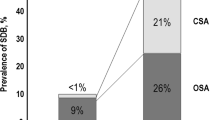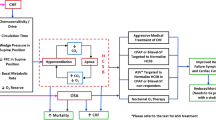Abstract
It is likely sleep apnea is highly prevalent in patients with congestive heart failure (CHF). However, as awareness is low and consensus guidelines do not exist, sleep apnea is not routinely screened for or diagnosed in CHF practice. Untreated sleep apnea may promote fatigue as well as left ventricular dysfunction, disease progression, and increased mortality. Available screening tools lack sensitivity or specificity, and there are insufficient numbers of sleep laboratories to accommodate the potentially large number of patient referrals with CHF for definitive diagnosis. In CHF patients with obstructive sleep apnea and sleepiness, treatment includes continuous positive airway pressure which may improve left ventricular function; optimal treatment for the non-sleepy patient is not established. There is no consensus regarding treatment for central sleep apnea. Studies which evaluate cardiovascular endpoints will be necessary to define management strategies for patients with CHF and either obstructive or central sleep apnea.
Similar content being viewed by others
References and Recommended Reading
Shamsuzzaman AS, Gersh BJ, Somers VK: Obstructive sleep apnea: implications for cardiac and vascular disease. JAMA 2003, 290:1906–1914.
Bradley TD, Floras JS: Sleep apnea and heart failure: part I: obstructive sleep apnea. Circulation 2003, 107:1671–1678.
Bradley TD, Floras JS: Sleep apnea and heart failure: part II: central sleep apnea. Circulation 2003, 107:1822–1826.
Shahar E, Whitney CW, Redline S, et al.: Sleep disordered-breathing and cardiovascular disease; cross-sectional results of the Sleep Heart Health Study. Am J Respir Crit Care Med 2001, 163:19–25.
Lanfranchi PA, Somers VK, Braghiroli A, et al.: Central sleep apnea in left ventricular dysfunction. Circulation 2003, 107:737–732.
Sin DD, Logan AG, Fitzgerald FS, et al.: Effects of continuous positive airway pressure on cardiovascular outcomes in heart failure patients with and without Cheyne-Stokes respiration. Circulation 2000, 102:61–66.
Kaneko Y, Floras JS, Usui K, et al.: Cardiovascular effects of continuous positive airway pressure in patients with heart failure and obstructive sleep apnea. N Engl J Med 2003, 348:1233–1241.
Mansfied D, Gollogly NC, Kaye DM, et al.: Controlled trials of continuous positive airway pressure in obstructive sleep apnea and heart failure. Am J Respir Crit Care Med 2004, 16:361–366.
Lanfranchi PA, Braghiroli A, Bosimini E, et al.: Prognostic value of nocturnal Cheyne-Stokes respiration in chronic heart failure. Circulation 1999, 99:1435–1440.
Javaheri S, Parker TJ, Liming JD, et al.: Sleep apnea in 81 ambulatory male patients with stable heart failure: types and their prevalences, consequences and presentations. Circulation 1998, 97:2154–2159.
Series F, Kimoff RJ, Morrison D, et al.: Prospective evaluation of nocturnal oximetry for detection of sleep-related breathing disturbances in patients with chronic heart failure. Chest 2005, 127:1507–1514.
Chan J, Sanderson J, Chan W, et al.: Prevalence of sleep-disordered breathing in diastolic heart failure. Chest 1997, 111:1488–1493.
Tremel F, Pepin JL, Veale D, et al.: High prevalence and persistence of sleep apnea in patients referred for left ventricular failure and medically treated over 2 months. Eur Heart J 1999; 20:1201–1209.
Ferrier K, Campbell A, Yee B, et al.: Sleep-disordered breathing occurs frequently in stable outpatients with congestive heart failure. Chest 2005, 128:2116–2122.
Lofaso F, Verschueren P, Rande JL, et al.: Prevalence of sleep-disordered breathing in patients on a heart transplant waiting list. Chest 1994, 106:1689–1694.
Young T, Palta M, Dempsey J, et al.: The occurrence of sleep-disordered breathing among middle-aged adults. N Engl J Med 1993, 328:1230–1235.
Sin DD, Fitzgerald FS, Parker JD, et al.: Risk factors for central and obstructive sleep apnea in 450 men and women with congestive heart failure. Am J Respir Crit Care Med 1999, 160:1101–1106.
Redfield MM, Jacobsen SJ, Burnett JC Jr, et al.: Burden of systolic and diastolic ventricular dysfunction in the community: appreciating the scope of the heart failure epidemic. JAMA 2003, 289:194–202.
Virolainen J, Ventila M, Turto H, et al.: Effects of negative intrathoracic pressure on left ventricular pressure dynamics and relaxation. J Appl Physiol 1995, 79:455–460.
Somers VK, Dyken ME, Skinner JL: Autonomic and hemodynamic responses and interactions during the Mueller maneuver in humans. J Auton Nerv Syst 1993, 44:253–259.
Bradley TD, Hall MJ, Ando S, et al.: Hemodynamic effects of simulated obstructive apneas in humans with and without heart failure. Chest 2001, 119:1827–1835.
Kraiczki H, Caidahl K, Samuelsson A, et al.: Impairment of vascular endothelial function and left ventricular filling: association with the severity of apnea-induced hypoxemia during sleep. Chest 2001, 119:1085–1091.
Kato M, Roberts-Thomson P, Phillips BG, et al.: Impairment of endothelium-dependent vasodilation of resistance vessels in patients with obstructive sleep apnea. Circulation 2000, 102:2607–2610.
Shamsuzzaman AS, Winnicki M, Lanfranchi PA, et al.: Elevated C-reactive protein in patients with obstructive sleep apnea. Circulation 2002, 105:2462–2464.
El-Solh AA, Mador MJ, Sikka P, et al.: Adhesion molecules in patients with coronary artery disease and moderate-to-severe obstructive sleep apnea. Chest 2002, 121:1541–1547.
Vgontzas AN, Papanicolaou DA, Bixler EO, et al.: Sleep apnea and daytime sleepiness and fatigue: relation to visceral obesity, insulin resistance, and hypercytokinemia. J Clin Endocrinol Metab 2000, 85:1151–1158.
Grimm W, Hoffmann J, Menz V, et al.: Electrophysiologic evaluation of sinus node function and atrioventricular conduction in patients with prolonged ventricular asystole during obstructive sleep apnea. Am J Cardiol 1996, 77:1310–1314.
Somers VK, Dyken M, Mark AL, et al.: Parasympathetic hyperresponsiveness and bradyarrhythmias during apnea in hypertension. Clin Auton Res 1992, 2:171–176.
Gami AS, Pressman G, Caples SM, et al.: Association of atrial fibrillation and obstructive sleep apnea. Circulation 2004, 110:364–367.
Gami AS, Hodge DO, Herges RM, et al.: Obstructive sleep apnea, obesity, and the risk of incident atrial fibrillation. JAMA 2007, 49:565–571.
Gami AS, Howard DE, Olson EJ, et al.: Day-night-pattern of sudden death in obstructive sleep apnea. N Engl J Med 2005, 352:1206–1214.
Javaheri S, Parker TJ, Wexler L, et al.: Occult sleep-disordered breathing in stable congestive heart failure. Ann Intern Med 1995, 122:487–492.
Javaheri S: A mechanism of central sleep apnea in patients with heart failure. N Engl J Med 1999, 341:949–954.
Corra U, Pistono M, Mezzani A, et al.: Sleep and exertional periodic breathing in chronic heart failure. Circulation 2006, 113:44–50.
Artz M, Harth, M, Luchner A, et al.: Enhanced ventilatory response to exercise in patients with chronic heart failure and central sleep apnea. Circulation 2003, 107:1998–2003.
van de Borne PJH, Oren R, Abouassaly C, et al.: Effect of Cheyne-Stokes respiration on muscle sympathetic nerve activity in severe congestive heart failure secondary to ischemic or idiopathic dilated cardiomyopathy. Am J Cardiol 1998, 81:432–436.
Naughton MT, Bernard DC, Liu PP, et al.: Effects of nasal CPAP on sympathetic activity in patients with heart failure and central sleep apnea. Am J Respir Crit Care Med 1995, 152:473–479.
Bradley TD, Logan AG, Kimoff RJ, et al.: Continuous positive airway pressure for central sleep apnea and heart failure. N Engl J Med 2005, 353:2025–2033.
Netzer NC, Stoohs RA, Netzer CM, et al.: Using the Berlin questionnaire to identify patients at risk for sleep apnea syndrome. Ann Inter Med 1999, 131:485–491.
Hunt S, Abraham MR, Chin MH, et al.: ACC/AHA 2005 guideline update for the diagnosis and management of chronic heart failure in the adult: a report of the American College of Cardiology/American Heart Association Task Force on practice guidelines (writing committee to update the 2001 guidelines for the evaluation and management of heart failure): developed in collaboration with the American College of Chest Physicians and the International Society for Heart and Lung Transplantation: endorsed by the Heart Rhythm Society. Circulation 2005, 112:e154–235.
Naughton MT: Routine polysomnography is indicated in congestive heart failure. J Clin Sleep Med 2005, 1:16–18.
Pack AI, Goldberg LR: Routine polysomnography is not indicated in congestive heart failure. J Clin Sleep Med 2005, 1:19–22.
Artz M, Yount T, Finn L, et al.: Sleepiness and sleep in patients with both systolic heart failure and obstructive sleep apnea. Arch Intern Med 2006, 166:1716–172.
Javaheri S, Corbett BS: Association of low PaCO2 with central sleep apnea and ventricular arrhythmias in ambulatory patients with stable heart failure. Ann Intern Med 1998, 128:204–207.
Usui K, Bradley TD, Spaak J, et al.: Inhibition of awake sympathetic nerve activity of heart failure patients with obstructive sleep apnea syndrome affects left ventricular diastolic function: effects of nasal continuous positive airway pressure in men. Circulation 2005, 112:375–383.
Solin P, Bergin P, Richardson M, et al.: Influence of pulmonary capillary wedge pressure on central apnea in heart failure. Circulation 1999, 99:1574–1579.
Tamura A, Kawano Y, Naono S, et al.: Relationship between beta-blocker treatment and the severity of central sleep apnea in chronic heart failure. Chest 2007, 131:130–135.
Sinha AM, Skobel EC, Breithardt OA, et al.: Cardiac resynchronization therapy improves central sleep apnea and Cheyne-Stokes respiration in patients with chronic heart failure. JAMA 2004, 44:68–71.
Philippe C, Stoica-Herman M, Drouot X, et al.: Compliance with and effectiveness of adaptive servoventilation versus continuous positive airway pressure in the treatment of Cheyne-Stokes respiration in heart failure over a six month period. Heart 2006, 92:337–342.
Sasayama S, Izumi T, Seino Y, et al.: Effects of nocturnal oxygen therapy on outcome measures in patients with chronic heart failure and Cheyne-Stokes respiration. Circ J 2006, 70:1–7.
Somers VK, Dyken ME, Clary MP, Abboud FM: Sympathetic neural mechanisms in obstructive sleep apnea. J Clin Invest 1995, 96:1897–1904.
Author information
Authors and Affiliations
Corresponding author
Rights and permissions
About this article
Cite this article
Olson, L.J., Somers, V.K. Sleep apnea: Implications for heart failure. Curr Heart Fail Rep 4, 63–69 (2007). https://doi.org/10.1007/s11897-007-0002-9
Published:
Issue Date:
DOI: https://doi.org/10.1007/s11897-007-0002-9




